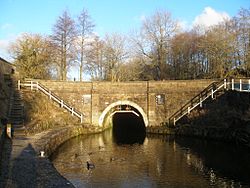Foulridge Tunnel facts for kids
 |
|
| Southern entrance | |
| Overview | |
|---|---|
| Location | Foulridge |
| Coordinates | 53°52′28″N 2°10′56″W / 53.8745°N 2.1821°W |
| Status | Open |
| Waterway | Leeds and Liverpool Canal |
| Start | 53°52′41″N 2°10′21″W / 53.8781°N 2.1726°W |
| End | 53°52′15″N 2°11′30″W / 53.8708°N 2.1916°W |
| Operation | |
| Owner | Canal & River Trust |
| Technical | |
| Design engineer | Robert Whitworth Samuel Fletcher |
| Construction | 1792–1796 |
| Length | 1,630 yards (1,490 m) |
| Tunnel clearance | 13 feet (4.0 m) |
| Width | 17 feet (5.2 m) |
| Towpath | No |
| Boat-passable | Yes |
The Foulridge Tunnel is a long tunnel for boats on the Leeds and Liverpool Canal. You can find it in Foulridge, Lancashire, England. People sometimes call it the Mile Tunnel. It's about 1,490 meters (or 0.9 miles) long. Samuel Fletcher built it, following plans made by Robert Whitworth in 1789. This tunnel is special because it's the longest one in the UK where you can still paddle through in a canoe or kayak.
Why the Tunnel Was Built
Building the Leeds and Liverpool Canal started in 1770. However, work stopped during the American Revolutionary War because the project was costing too much money.
The first plan for the canal didn't include a tunnel at Foulridge. Instead, more locks would have lifted the canal higher. This would have created a 1-mile (1.6 km) long section, about 30 feet (9.1 m) higher, that would pass through a reservoir.
Before work on the canal started again, Robert Whitworth became the new engineer. He looked at the route again and suggested changes. These changes were made to make sure the canal had enough water.
How the Tunnel Was Built
Construction of the tunnel began in December 1792. The project took almost five years to finish. The last three years were spent building the final 1,280 meters (1,400 yards) of the tunnel.
Only about two-fifths of the tunnel's length, which is 640 meters (700 yards), was built using the usual method. This method involved digging shafts down from the surface and then digging horizontally.
Most of the tunnel was built using a different method called "cut and cover." This meant digging a large trench in the hillside. Workers then built the tunnel lining inside this trench. After the tunnel was built, the trench was filled back in with earth. This method was used because the ground in the hillside was too loose. It wasn't stable enough to dig a tunnel 21 meters (69 feet) below the hilltop using the usual method.
Once the tunnel was finished, the canal opened up to Colne Road in Burnley in 1796. It took another five years to complete a very large embankment needed to cross the valley there.
Tunnel History and Use
The Foulridge Tunnel opened in May 1796. The Leeds Intelligencer newspaper said it was "the most complete work of the kind in England, if not in Europe."
There's a fun local story about the tunnel. It says that on September 24, 1912, a cow fell into the canal near the southern end. The cow then swam all the way through the tunnel! After she was helped out, she was given brandy (or rum) at the Hole in the Wall pub in Foulridge to help her recover.
The tunnel does not have a towpath, which is a path for horses to pull boats. So, boats used to get through the tunnel by "legging." This meant people would lie on their backs on the boat and use their feet against the tunnel walls to push the boat through. Meanwhile, the horses walked over the hill above the tunnel.
Legging stopped at Foulridge in 1886 after an accident. A special steam tug boat was brought in during 1880 to pull vessels through the tunnel. This tug could go through and come back without needing to turn around. Later, a diesel tug replaced the steam boat. This tug service ended in 1937.
To make sure boats didn't crash inside the tunnel, a telephone system was put in place to control when boats could enter. In 1963, this was replaced by traffic lights.
In 2017, the Canal & River Trust allowed unpowered boats like canoes and kayaks to use the tunnel.

